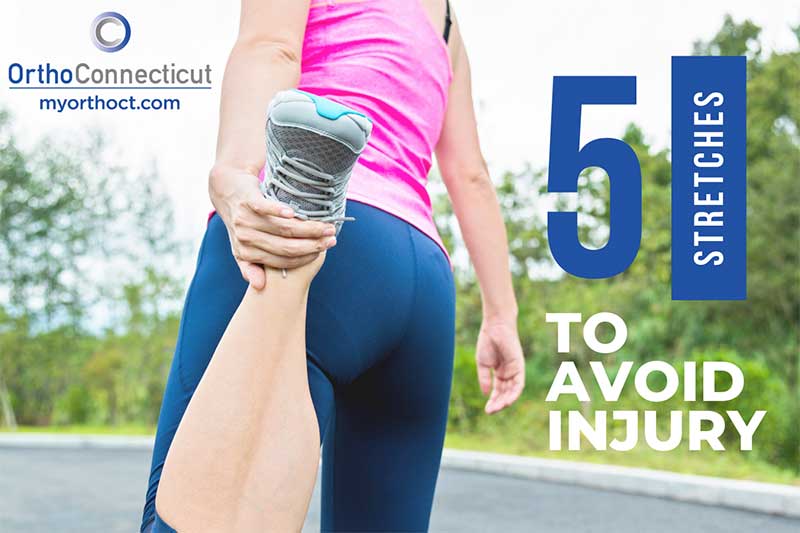Brought to you by OrthoConnecticut
Stretching before and after a run is important to prevent injury, muscle stiffness and pain. There are differing opinions about whether you should stretch before or after running, but both are valuable. Stretching beforehand maximizes your flexibility so you can get the most out of your run, while stretching after a run prevents muscles from becoming stiff and painful.
There are numerous stretches you can do to warm up and increase flexibility. However, if you forget to do your stretches at home before you leave for your run, here are some easy stretches you can do outside, without the aid of special equipment, right before and after you run.
Standing Quad Stretch
When the primary thigh muscles, the quadriceps (or quads), become tight, it can lead to misalignment of the hips and back, along with knee pain. To stretch the quads:
- Stand up straight with your feet apart, directly below your hips.
- Bend the right knee and bring the right foot up behind you toward the buttocks, and grab with your right hand.
- Keep the right knee pointed toward the ground and gently push the hips forward slightly, keeping the knees and thighs together. You should feed this stretch in front of your thigh from your hips to your knee.
- Hold for 30 seconds and then switch legs.
Toe Touch
This stretch improves the flexibility of the hamstrings, the muscles on the back of the thighs which continuously contract and lengthen as you run.
- Stand with the feet together, with knees straight but not locked.
- Bending at the hips, slowly lower the head down toward the knees, keeping the back as straight as possible.
- Reach the fingers toward the toes and hold for 30 seconds.
- Rise slowly back up to standing.
Heel Raises
This is a stretch for the ankles, which work hard while you run to stabilize the feet and propel the body forward.
- Stand with the back straight.
- Slowly rise onto the balls of the feet without locking the knees and hold for 10 seconds.
- Slowly lower the heels back down to the floor.
- Repeat the exercise 3 times, maintaining control both on the way up and down.
Calf Stretch
The calf muscles, located in the back of your lower legs, absorb the impact when running and can easily stiffen up afterwards. You should feel this stretch down the length of the calf, from the knee to the ankle.
- Stand with your right foot behind your left, about 2 feet apart.
- Lean forward, bending your left knee while keeping your right leg (behind you) straight.
- Keep both feet facing forward, straighten your back, and hold the pose for at least 30 seconds.
- Repeat with the other leg in front.
Iliotibial (IT) Band Stretch
The iliotibial band, or IT band, runs on the outside of your thigh between your hip and shin, and is susceptible to injury when it tightens. This stretch is also good for your hip muscles.
- Cross your left ankle behind your right ankle.
- Keep your right arm out to your side for balance while stretching your left arm over your head.
- Reach up and over with your torso and arm, stretching toward your right side.
- Hold for at least 30 seconds and repeat with the other leg.
Note: When your left ankle is crossed behind your right ankle, and you’re leaning toward the right, you’ll feel the stretch in your left leg
We hope these simple stretches prevent injury, but if you do happen to have a complication from running or any other sport, we are here for you. Contact us ›















